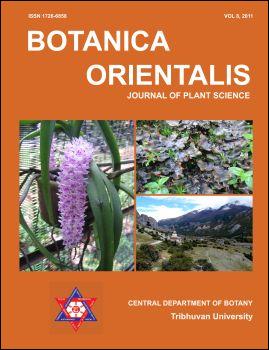Distribution pattern of the epiphytic orchid Rhynchostylis retusa under strong human influence in Kathmandu valley, Nepal
DOI:
https://doi.org/10.3126/botor.v8i0.5956Abstract
We studied distribution pattern of the epiphytic orchid Rhynchostylis retusa (L.) Blume with respect to (i) site characteristics and host conditions, and (ii) the type and intensity of land use in Kathmandu Valley, central Nepal. We established a 1.5 km grid net and analyzed epiphytic orchids at each point, searching for 10 trees as close as possible to the grid point. There we analyzed bark water-holding capacity, bark pH, bark roughness and light intensity. We assessed the probability of the occurrence of R. retusa in different land use patterns. Our results indicated that R. retusa was not a host-specific orchid species. It was found on different host tree species. However, Ficus religiosa was the most common host species. The correlation between R. retusa occurrence and microclimate condition was weak. R. retusa, to a certain degree, preferred light intensity of 40-80% of full sun light, rough bark with pH around 6.5 and bark with a wide range of water holding capacity. The distribution pattern of R. retusa was influenced by certain types of land use. The probability to find R. retusa was highest in forest patches and parks and lowest in agricultural and dense populated area. The study reveals that to improve the population size of R. retusa, trees (mainly Alnus nepalensis, Ficus religiosa and Schima wallichii) should be planted in areas where the orchid species is recently missing.
doi: http://dx.doi.org/10.3126/botor.v8i0.5956
Botanica Orientalis – Journal of Plant Science (2011) 8: 90-99




